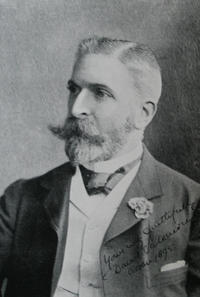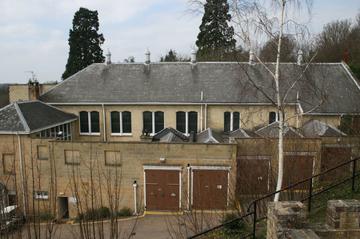Pioneering Technology at Salomons
The house on the Salomons estate, Broomhill, near Tunbridge Wells in Kent, is one of the most important and remarkable in the history of domestic technology. David Salomons, a founder of the London and Westminster Bank (which later became NatWest) bought a modest villa on this site around 1829 and set about replacing it with a new house from 1852. Salomons was a prominent campaigner for Jewish emancipation and in 1851 was elected to Parliament, although he was unable to take up his seat until 1858 when the law that required MPs to swear a Christian oath of allegiance was changed. He was made a baronet in 1869. Over several years, Salomons rebuilt the original house on a much larger scale, with many modern comforts including gas lighting, supplied by a small private gas works 300m to the south of the house.

David Lionel Salomons (by permission of the Salomons Museum)
David Salomons and his wife Jeannette had no children but brought up their nephew, David Lionel Salomons, as their son after his father’s death. David Lionel had no interest in finance and, when he inherited the estate on his uncle’s death in 1873, he devoted his energies to scientific study. (His pioneering work in the field of photography is described elsewhere on this web site.) In 1874, he built a workshop for experiments with electric motors and lighting, initially powered by batteries. Parts of the estate are believed to have been lit with electric arc lights from around this date, perhaps four years before William Armstrong was using with electric arc lighting at Cragside. The first permanent generator plant on the estate was built around 1882, initially driven by steam engines, replaced by gas engines by 1893. A particular focus of David Lionel’s research in the field of electric lighting was the design, installation and management of the lead-acid batteries that were a key element of all early DC electricity plants.

The Battery Room at Broomhill, from 'Electric Light Installations and the Management of Accumulators' by David Salomons, 1890
These not only stored the electrical power but also regulated the voltage, and a huge bank of 55 of them was required for a typical 110v system. David Lionel published the results of this work in a book, Management of Accumulators and private electric light installations, in 1887, that was, for many years, the definitive work on the subject. The large battery room that David Lionel describes in his book as a model to be followed, still survives.
Perhaps even more remarkable is the large theatre and laboratory complex, including photographic darkrooms, built to the north of the main house c1894. Here, concerts and magic lantern shows were held, and the public could watch demonstrations of scientific experiments from a viewing gallery. Much of the original wiring and equipment, including motorised curtains and window shutters, still survive in situ. In 1894, David Lionel added a stable block, which allegedly included an electrically-powered feeding system for the horses, that has, sadly, not survived. However, the building itself is perhaps the most impressive surviving example of a state-of-the art late-Victorian stables.

The 1902 motor stables, with the c1894 theatre and laboratory building behind ©Ian West
Unsurprisingly, David Lionel was also an early adopter of the motor car. Having built his own electric tricycle in 1874, he imported the second petrol-driven car in England from France in 1895. In 1902, he built a suite of four motor houses with workshops and chauffeurs’ accommodation, probably the best-preserved example of such a facility in Britain. Characteristically, he shared his ideas on this subject in a chapter entitled The Motor Stable and its Management in one of the earliest books on motoring, in published in 1902. The motor houses were subject to a detailed survey by what was then English Heritage in 2009 (https://research.historicengland.org.uk/Report.aspx?i=14723), but most of the estate’s other remarkable features remain to receive the attention they deserve.
David Lionel died in 1925 and his only surviving offspring, his daughter Vera, gave the house to Kent County Council in the 1930s for use for medical or educational use. One condition of the gift was that two rooms – the Sculpture Room and the adjoining Old Library – were to be preserved in their original condition and used as a museum about the lives of the two David Salomons.
Header photo: interior of the generator building at Broomhill (credit The Salomons Museum)
https://www.salomons-estate.com



